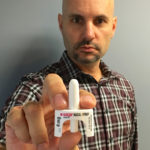Lifesaving measure for opioid overdose available to the public without prescription
September 14, 2018 • Uncategorized

When the U.S. Surgeon General published a recent health advisory – the first such alert in the last decade – asking for the public’s assistance in tackling the nation’s growing opioid epidemic, Dr. Scott Walters from the UNTHSC School of Public Health made plans to do his part.
“Be prepared. Get naloxone. Save a Life,” the Surgeon General said. “For patients currently taking high doses of opioids as prescribed for pain, individuals misusing prescription opioids and individuals using illicit opioids such as heroin or fentanyl, health care practitioners, family and friends of people who have an opioid use disorder, and community members who come into contact with people at risk for opioid overdose, knowing how to use naloxone and keeping it within reach can save a life.”
As a behavioral health professor and researcher at the UNTHSC School of Public Health, Dr. Walters has worked with people who are homeless, on probation and at risk of interpersonal violence. His research takes him to community shelters, institutional settings and out to the streets.
“Being able to react quickly when an overdose is suspected could mean the difference between life and death,” Dr. Walters said. “If there is a chance I could help someone in an emergency, I want to be ready. Not many people, though, know where or how to get naloxone, or realize that it’s available through their insurance without questions or a prescription.”
Naloxone, sometimes referred to by the brand name Narcan, is a safe antidote for overdose that has been used in hospitals and among emergency medical personnel for years, Dr. Walters said. It is available in injection form or as a nasal spray.
“There are no side effects,” he said. “The only result is to reverse the deadly threat of an overdose.”
Over the last 15 years, individuals, families and communities across the U.S. have been tragically affected by the opioid crisis, with the number of deaths from prescription and illicit opioids doubling from 21,089 in 2010 to 42,249 in 2016.
“The problem is real, and unfortunately, it is still growing,” Dr. Walters said. “We can all help by understanding the signs of opioid abuse and knowing what to do in an emergency.”
Obtaining naloxone was initially challenging for Dr. Walters.
The first pharmacy he tried was hesitant and not familiar with the new guidelines. To bill his insurance, they suggested he needed a doctor’s prescription.
A call to his doctor didn’t help either, as the physician wasn’t comfortable with moving away from typical protocol for prescribing a medication. Because it would be used for someone else, the doctor didn’t feel able to assist.
As Dr. Walters pursued it further with the Texas Pharmacy Association, he discovered that a standing naloxone prescription order exists for all Texas citizens and is now applicable in most other states.
A visit to a second pharmacy with this new information yielded a better outcome. The medication was provided without a personal prescription, at a cost of his usual insurance copay.
Texas Society of Addiction Medicine President Dr. Carlos F. Tirado, who signed the state’s standing order more than one year ago, said, “This medication has been available to the public for quite a while. We still have a lot of work to do in educating and informing pharmacists, physicians and citizens on how to obtain naloxone and the power we all have to save someone’s life. Anyone who has a concern about someone they know, or someone close to them, can get this medication at any pharmacy.”
People who keep opiates or painkillers at home or who have curious teenagers might be wise to have this antidote on hand, Dr. Walters recommends.
“Many colleges, in fact, keep naloxone available in case of emergency,” Dr. Walters said. “People who work in healthcare, public health or other fields where they encounter vulnerable populations, or anyone who suspects they might be around someone who could be abusing drugs, may also benefit.”

Social media